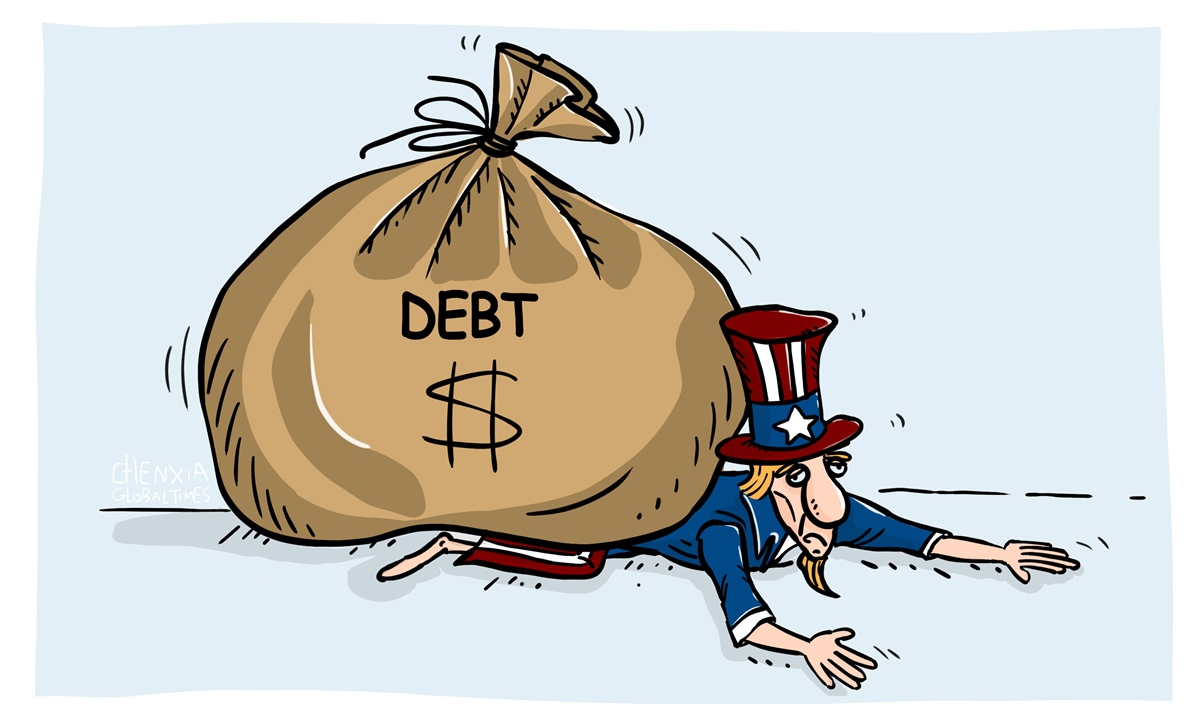
Illustration: Chen Xia/GT
While the withdrawal from Afghanistan war has triggered reflection on US military interventions across the world over the two decades since 9/11, 2001, the troubles are far from over and another far worse crisis is looming in the country as the US war economy has already thrown the US debt level onto an unsustainable track.
The urgency of America's debt problem just entered a danger zone as US Treasury Secretary Janet Yellen warned on Wednesday that the US could default on its debt sometime in October if Congress doesn't raise or suspend the debt limit. It would mark the first time in history that the US couldn't meet its obligations, resulting in "irreparable harm" to the US economy and to global financial markets.
While it is no secret that the US debt is on an unsustainable footing, it is still surprising to know that a real debt crisis is just around the corner. According to forecasting by the Congressional Budget Office, the country's debt will grow by almost 40 percent from 2019's level to $24.3 trillion in 2022. What's even more worrying is that the US debt is growing much faster than the economy, an indication of the increasingly deteriorating debt problem. Meanwhile, the IMF estimates that US government debt-to-GDP ratio has hit 109 percent in 2021, far exceeding the debt level of a healthy economy.
Although the Afghanistan war, which cost the US more than $2 trillion since 2001, is considered one of the causes contributing to America's skyrocketing debt problem, it is worth noting that the troop withdrawal is not enough to address its debt woes.
Some might optimistically argue that the debt burden could be relieved once the economy manages a strong rebound from the harm caused by the pandemic and the government doesn't need to fork out additional welfare payments connected with COVID-19. That might also be mainstream thinking of many from the US government. Since the beginning of the global pandemic, the Federal Reserve has been trying to buy time for the US economic recovery by unleashing a flood of liquidity and using various financial tools to support US government expenditure.
Yet, given a series of major economic policy blunders, the US economic recovery is progressing much slower than expected. The inefficient fight against COVID-19 and the still raging COVID-19 cases driven by the Delta variant, a main reason behind the record high of US job openings in July, will continue to challenge its bumpy economic recovery.
Moreover, the US economy hasn't benefited from its trade war with China, but some politicians in Washington still advocate further suppression on China and Chinese companies, disregarding the fact that an escalation of trade tensions will only make the US economy suffer more than the country's prolonged Afghan occupation.
Against this backdrop, risks facing the US financial system are severe, because there is a limit to everything, including what's left in the Fed's toolbox. As US debt risks accumulate, the US has become the biggest source of uncertainty within the global recovery post the pandemic. If a US debt crisis breaks out, it will drag the world's economy down with it.
Global investors have started to anxiously view US debt. For instance, Japan's GPIF, the world's biggest pension fund, lowered US government bonds and bills to 35 percent of its foreign debt holdings in the 12 months ended March, from 47 percent, according to a Bloomberg report.
Data from the US Treasury Department showed China's holdings of US Treasuries dropped to $1.062 trillion in June, down $16.5 billion from the previous month. It marked the fourth consecutive month China has trimmed its holdings of US Treasury bonds. If there is no sign of abating in US debt risk, it is necessary for China to continue lowering its holdings of US Treasury bonds to reduce risk exposure.




